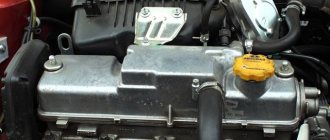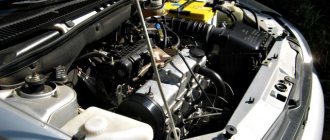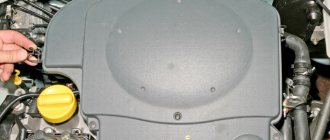Category: ENGINE
- Engine characteristics 21129
- Engine design 21129
- Gas distribution mechanism
- Cooling system
- Electricity supply
- Lubrication system
- Advantages and disadvantages
- Engine Maintenance 21129
- Tuning the Largus engine and other models with engine 21129
Starting from 2013, engine 21129 was put into mass production. The power unit is a modernized version of model 21127. The engine is intended for use on Lada X Ray, Lada Vesta, Lada Largus. Compared to the previous model of the power unit, the motor has higher power and environmental friendliness.
Engine characteristics 21129
The engine of the Lada X-ray and other models is unpretentious to operating conditions and fuel quality. The motor has the following technical characteristics:
- Power unit brand - 21129;
- Type of power plant - injection;
- Number of working cycles - 4;
- Number of working cylinders - 4;
- The number of timing valves per cylinder is 2 exhaust and 2 intake;
- The cylinder block is cast iron;
- The piston stroke from top to bottom dead center is 75.6 millimeters;
- Working cylinder diameter - 8.2 cm;
- Power plant volume - 1596 cm3;
- Compression – 10.5;
- The maximum power of the power unit is 106 horsepower;
- Connecting rod length - 133 mm;
- The fuel used is gasoline;
- Compliance with environmental standards - Euro 5;
- The operating order of the cylinders is 1,3,4,2;
- Curb weight of the power plant - 109 kg;
- The oil volume in the crankcase of the power unit is 3.2 liters;
- Engine life 21129 - 200,000 km;
- Average gasoline consumption is 6.6 liters per 100 km.
REFERENCE: the moving parts of the power unit are lubricated with motor oil with a viscosity grade from 0W-30 to 15W-40. The manufacturer recommends using oil with a viscosity of 5W40 and 5W30 for lubrication.
Malfunctions: causes, elimination
Despite the fact that the 16 valve engine 21129 with adjustable air intake flows and hydraulic valve clearance compensators is considered a very reliable power drive, malfunctions still occur:
| Gasoline consumption has increased | 1) catalyst is clogged 2) fuel pump failure 3) the air filter is clogged | 1)cleaning the exhaust system 2) pump replacement 3) cartridge change |
| Glow type ignition (operation after switching off) | 1) overheating 2) carbon deposits on the surfaces of valves and combustion chambers | 1) repair of the cooling system, refilling of coolant 2) flushing of the system |
| Emergency pressure indication | 1) wear of the oil pump or main bearings 2) sensor malfunction 3) circuit closure 4) oil level is insufficient | 1) replacement of consumables 2) installation of a new sensor 3) wiring repair 4) adding oil |
| Reduced cravings | 1) DPKV breakdown 2) clogged filters 3) COURT firmware failure 4) clutch wear 5) timing adjustment failure | 1) replacing the crankshaft position sensor 2) replacing filters 3) flashing 4)replacement of a set or disk 5) phase adjustment, belt replacement |
The 21129 engine rarely violates idling speed conditions due to the redundant adjustment system.
Gas distribution mechanism
The intake of the working mixture and the release of exhaust gases is carried out by a valve mechanism. Each working cylinder is equipped with two inlet and two exhaust valves. To control the valves, two cam-type camshafts are provided. The camshafts are driven by a belt, from a pulley mounted on the engine crankshaft.
To prevent lubricant from entering the cylinder during operation of the power unit, the valves are equipped with valve stem seals. To improve gas distribution, the manufacturer provides hydraulic compensators.
Cooling system
The motor is equipped with a forced-type liquid cooling system. Cooling of the liquid is carried out in the radiator. The movement of coolant in the radiator and cooling jacket is carried out using a water pump. It is belt driven from the crankshaft of the power unit.
For quick warm-up in the cold season, a thermostat is included in the cooling system. At low coolant temperatures, the thermostat closes a large circulation circle. This allows for rapid heating of the coolant. Once the required temperature is reached, the thermostat opens a large circle.
IMPORTANT: The manufacturer has equipped the power plant with cooling of the working mixture. This design allows you to increase power and reduce fuel consumption.
Electricity supply
The power plant is controlled by an electronic unit. The microprocessor of the unit receives information from sensors, on the basis of which it controls the power plant. The engine is powered by a battery and a DC generator.
When the engine is switched off, the power supply is supplied by the battery. The battery voltage is 12 volts. The negative wire is connected to the motor housing. After starting the engine, the consumers are powered by a DC generator.
The DC generator powers the engine ignition system and charges the battery. The generator is driven by a belt, from a pulley mounted on the crankshaft. To avoid voltage surges, a regulator relay is included in the circuit.
Cylinder block
The block is cast from high-strength cast iron. Cylinder numbering is carried out on the installation side of the crankshaft pulley. Each cylinder, based on the results of measuring its diameter, is assigned a size class.
Block 21126 is painted gray. Wall processing is carried out in accordance with the requirements of Federal Mogul. Block 21126 has three classes every 0.01 mm (A, B, C). The cylinder class mark is located on the bottom plane of the block.
AvtoVAZ pleases us with its innovations from time to time. For a long time, the VAZ series, from the cheap Lada to the stylish S7, was very popular. Later, the Lada Samara line appeared, represented by the VAZ-2108, VAZ-2109 and VAZ-21099. They were supplemented by the model range of cars of the 10th family. Now we are content with Kalinas, Grants, Priors and Vestas. Some of these models began to be equipped with a new power plant - engine 21127.
What prompted you to take such a step? And how can the new engine surprise domestic car enthusiasts now?! Let's try to answer these and other questions.
Advantages and disadvantages
The engine of the Lada X-ray and other models is reliable. The motor has the following advantages:
- Saving fuel and lubricants. The 21129 engine has low fuel and lubricant consumption. Such indicators were achieved thanks to the new firmware;
- Increased power. The maximum engine power is 106 horsepower. When tuning, it is possible to increase this figure;
- Compliance with European environmental standards. More complete combustion of fuel in the chamber allows not only to improve technical performance, but also to increase the environmental class to the Euro 5 standard;
- Improved additional equipment. The manufacturer installed a modernized DC generator and improved mounting pads on the engine of the Lada X-ray and other models;
- Reliability and service life of the engine 21129. The manufacturer declared the service life of the power plant to be 200,000 km.
The power plant has shortcomings. These include:
- Bending of valves when the timing belt breaks.
- When the belt breaks, the piston, moving to top dead center, bends the open valves;
- High cost of communication maintenance and repair due to the presence of expensive foreign-made parts;
- Poor quality of the cooling system thermostat. The engine takes a long time to warm up in the winter;
- The need to use high-quality fuel and expensive lubricants.
One of the differences
The new engine is based on the previous version of the internal combustion engine - VAZ-21126. The company did not plan to make any fundamental changes, however, there are serious differences.
The main feature is the use of a modern intake system with flaps, thanks to which air enters the cylinders a little differently. When the engine revs high, it travels a long way. At idle or low speeds, air first enters the resonance chamber. As a result, the fuel burns completely, which leads to improved performance of the VAZ-21127 engine.
Now under the hood of the car there are already 106 “horses”, although the engine volume remains the same – 1.6 liters. Moreover, this applies not only to high, but also to low speeds. And here you might think that with an increase in power, fuel consumption also increased. In fact, the efficiency remains the same. This is the same 6.7 liters per hundred kilometers.
Engine Maintenance 21129
For normal operation of the Lada Vesta and other models, it is necessary to carry out regular maintenance. For this:
- After covering 10,000-15,000 kilometers, it is necessary to replace the lubricant. The oil filter is replaced at the same time as the oil;
ATTENTION: Before changing the lubricant, you must warm up your unit. This will reduce the viscosity of the oil and speed up the draining process.
- After every 20,000 mileage, you should check the functionality of the spark plugs, DC generator drive belt, battery, and crankcase ventilation;
- When the Lada Xray and other models reach 45,000 mileage, it is necessary to check the functionality of the thermostat, the elasticity of the cooling system pipes and replace the antifreeze. Fuel filters are being replaced;
- After 100,000 miles, it is necessary to check the condition of the timing belt. If there is damage, a new belt should be installed.
Public opinion
As many owners of 2nd generation LADA Kalina cars equipped with the new engine note, they actually felt an increase in power. This was especially noticeable at low speeds. It takes 11.5 seconds to accelerate a car to a speed of 100 km/h, and this is a great merit for domestic transport.
As other reviews show, the 21127 engine worries a number of owners, which is associated with an already pressing problem - a high risk of timing belt breakage. But here you need to either come to terms with this state of affairs, or replace the pistons, as already mentioned above. A break is dangerous not only because of bent valves; other parts can also receive serious damage.
Tuning the Largus engine and other models with engine 21129
Modernization of power plants makes it possible to achieve higher technical characteristics. Improving engine performance is carried out in specialized workshops that have the appropriate equipment. For this purpose, specialists:
- The sleeves are bored to a diameter of 88 mm. This enlarges the combustion chamber;
- Lightweight pistons are installed;
- Smooth out irregularities in the intake and exhaust channels;
- Modernize the gas distribution mechanism;
- Flashing the electronic control unit.
IMPORTANT: The firmware of the electronic control unit is performed by highly qualified specialists. Violation of this rule can lead to complete failure of the product and costly repairs.
From the above it follows that the 21129 engine installed on the Lada Largus and other models is distinguished by its reliability and power. The manufacturer equipped the power plant with new attachments. By performing tuning, they improve the technical characteristics of the engine.
Four Well-Known Facts
The service life of the timing chain always exceeds the service life of the engine. This is the first fact, but a condition must be met: the oil change must be timely. In general, the circuit fails gradually, and this is accompanied by symptoms:
- Audible sounds (chirping) at idle speed;
- When the “problem area” passes, a phase shift may be observed.
The last defect is detected using computer diagnostics.
From the appearance of any symptom to the complete rupture of the chain, a certain time passes. And in general, a “defective circuit” can work for a long time. This was another, fourth fact.










